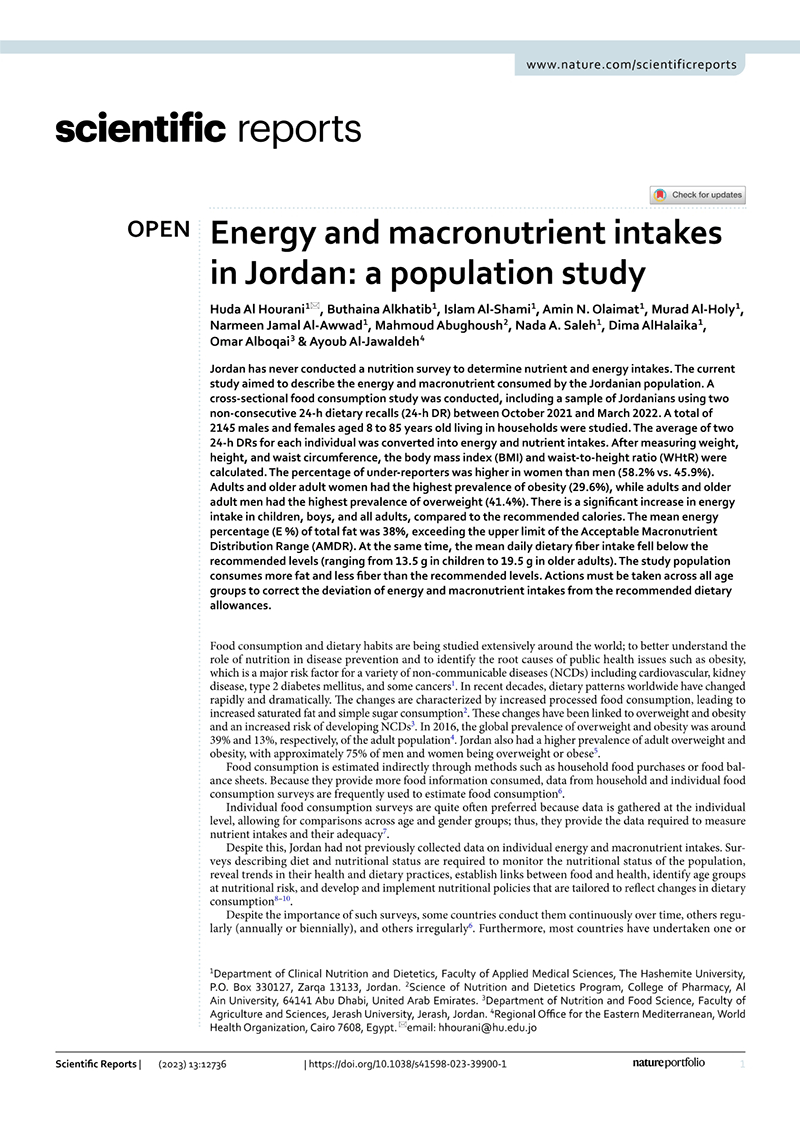
Energy and macronutrient intakes in Jordan: a population study
Publication date: 2023
Jordan has never conducted a nutrition survey to determine nutrient and energy intakes. The study aimed to describe the energy and macronutrient consumed by the Jordanian population. The study population consumes more fat and less fiber than the recommended levels. Actions must be taken across all age groups to correct the deviation of energy and macronutrient intakes from the recommended dietary allowances.
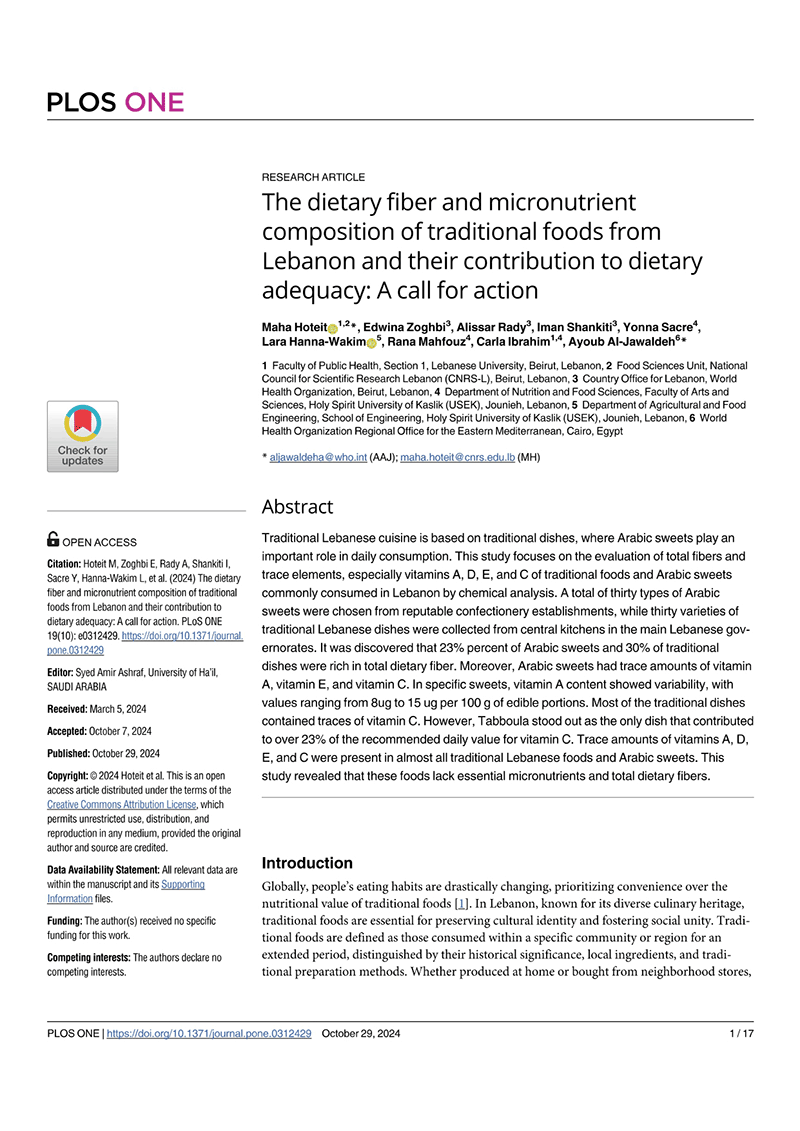
The dietary fiber and micronutrient composition of traditional foods from Lebanon and their contribution to dietary adequacy: a call for action
Publication date: 2023
Traditional Lebanese cuisine is based on traditional dishes, where Arabic sweets play an important role in daily consumption. This study focuses on the evaluation of total fibers and trace elements, especially vitamins A, D, E, and C of traditional foods and Arabic sweets commonly consumed in Lebanon by chemical analysis. This study revealed that these foods lack essential micronutrients and total dietary fibers.

Assessment of micronutrient situation among reproductive-age women (15-49) and under-five children in Sudan
Publication date: 2021
Micronutrient malnutrition is a form of undernutrition that causes diseases, and this is mainly due to insufficient intake of nutrients in daily foods. The aim of this study is to highlight the status of micronutrients among women of reproductive age (15–49 years of age) and their children in Sudan. The study concludes that anaemia showed high prevalence in women of reproductive age and children. Same for iron deficiency; it is considered a crucial problem in women of reproductive age, especially pregnant women and children.

Knowledge, attitudes, and practices related to dietary supplementation, before and during the COVID-19 pandemic: findings from a cross-sectional survey in the Lebanese population
Publication date: 2021
Clinical deficiencies of nutrients may increase susceptibility to infections. The objective of this research was to assess the usage, knowledge and attitudes towards dietary supplementation before and during the COVID-19 pandemic among Lebanese people. The findings show that there is a crucial need to increase awareness among Lebanese people regarding the use of dietary supplements.

Tea consumption reduces iron bioavailability from NaFeEDTA in nonanemic women and women with iron deficiency anemia: stable iron isotope studies in Morocco
Publication date: 2021
The study aims to quantify bioavailability of iron from NaFeEDTA when added to a wheat flour–based meal in both nonanemic women and women with iron deficiency anemia, when consumed with and without traditional Moroccan green tea. It concludes that fractional iron absorption from wheat flour-based meals without and with tea was ∼2-fold higher in women with iron deficiency anemia than in nonanemic women. Providing fortificant iron as NaFeEDTA cannot overcome the inhibition of tea polyphenols on iron absorption, even in iron deficiency anemia, where iron absorption is strongly upregulated.

Meta-analysis and systematic review of micro-and macro-nutrient intakes and trajectories of macro-nutrient supply in the Eastern Mediterranean Region
Publication date: 2021
The Eastern Mediterranean Region is experiencing a nutrition transition, characterized by the emergence of overnutrition and micro-nutrient deficiencies. This review examines the adequacy of nutrients in adults living in the Region. Moreover, it analyzes the food balance sheets for 1961–2018 to identify the trajectory of energy supply from macro-nutrients in the Region. Findings show that the nutrient energy intake was satisfactory overall, while fat and carbohydrate intake were high. Intake of vitamin D, calcium, potassium, zinc, and magnesium were below that recommended.

Assessment of vitamin A supplementation practices in countries of the Eastern Mediterranean Region: evidence to implementation
Publication date: 2021
Vitamin A is an essential nutrient necessary for human growth and development, with critical roles in vision, immune function reproduction and maintenance of epithelial cellular integrity. Inadequate intake of vitamin A places populations at risk of developing diseases associated with vitamin A deficiency, which is highly prevalent across the Eastern Mediterranean Region in children under 5 y and women of childbearing age. The objective of this study is to assess the vitamin A supplementation practices across the countries in the Region, determine the gaps in the supplementation practices and the issue with supplementing to healthy populations where vitamin A deficiency is not a public health concern, and provide recommendations for proper vitamin A supplementation within the Region.

Are countries of the Eastern Mediterranean Region on track towards meeting the World Health Assembly target for anemia? A review of evidence
Publication date: 2021
Anemia is a multifactorial condition, with a complex etiology that involves nutritional and non-nutritional factors. The misconception that iron deficiency is equivalent to anemia may mask the need to address other potential causative factors. This review paper aims to: (1) assess the burden of anemia vs. iron deficiency anemia amongst women of reproductive age, pregnant women and children under five years old in the Eastern Mediterranean Region; (2) evaluate trends in anemia prevalence and whether countries are on track towards meeting the World Health Assembly target for 2025; and (3) characterize anemia reduction efforts and provide a road map for future programmes.
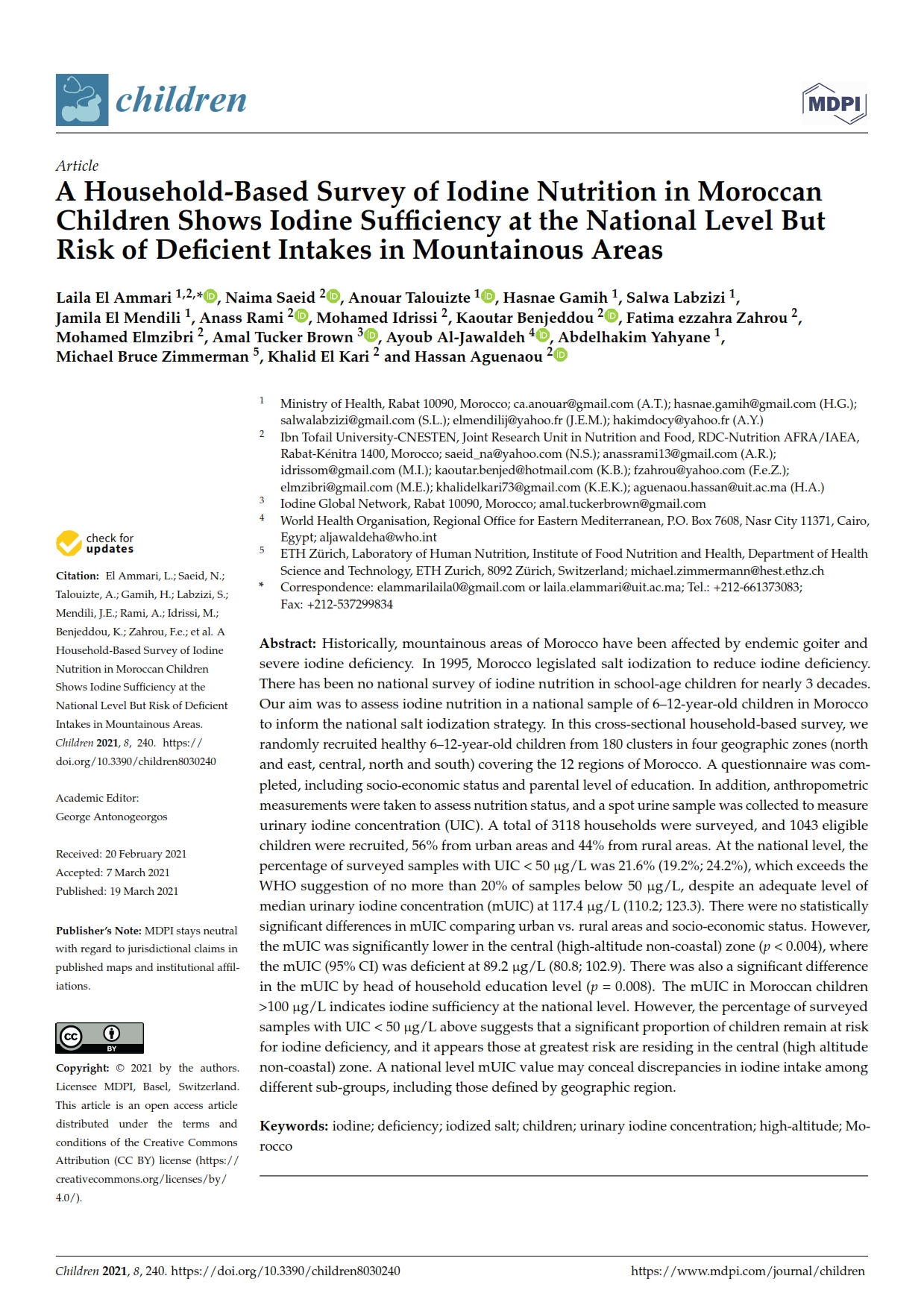
A household-based survey of iodine nutrition in Moroccan children shows iodine sufficiency at the national level but risk of deficient intakes in mountainous areas
Publication date: 2021
Historically, mountainous areas of Morocco have been affected by endemic goiter and severe iodine deficiency. In 1995, Morocco legislated salt iodization to reduce iodine deficiency. There has been no national survey of iodine nutrition in school-age children for nearly 3 decades. This study aims to assess iodine nutrition in a national sample of 6 to 12-year-old children in Morocco by measuring the urinary iodine concentration in spot urine samples to inform the national salt iodization strategy.
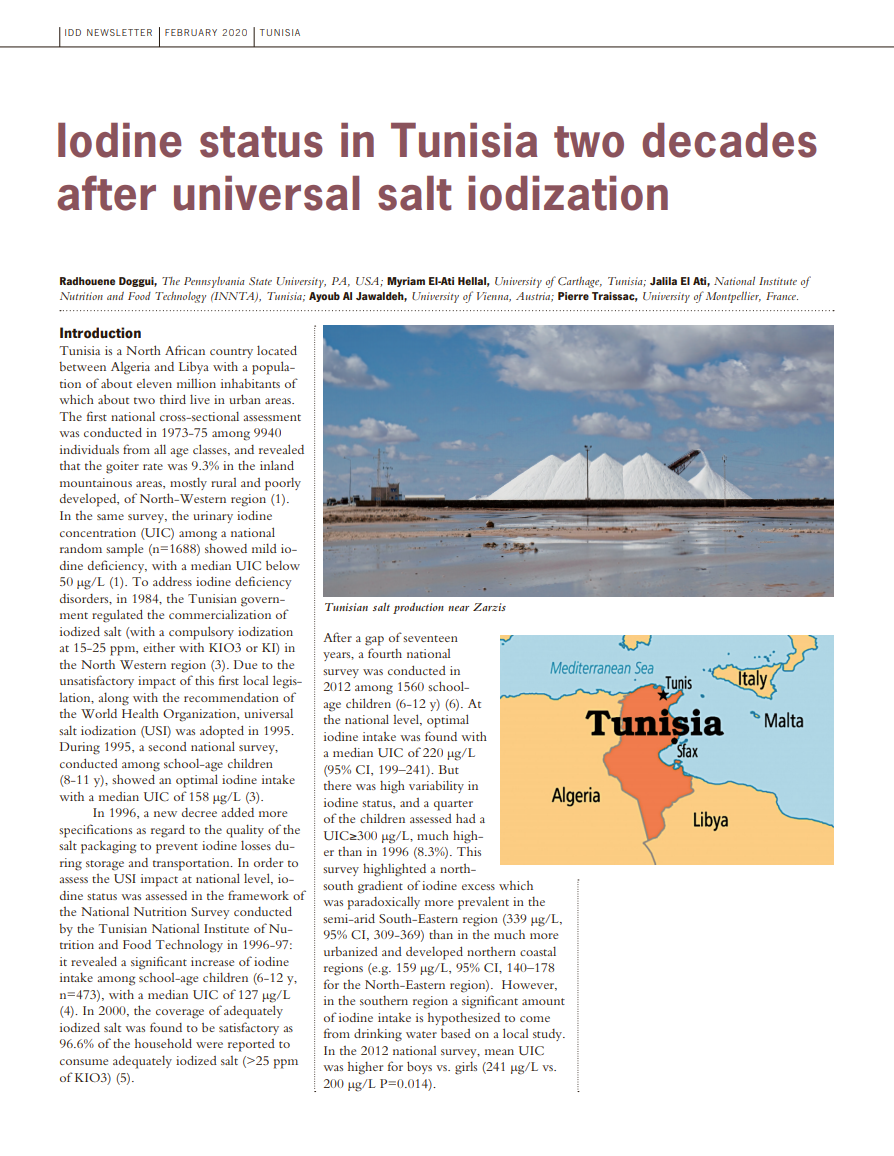
Iodine status in Tunisia two decades after universal salt iodization
Publication date: 2020
The article describes the iodine status and the efforts made to measure it during the last decades in Tunisia. In 2012, over 78% of Tunisian households were using iodized salt, but updated data are needed to ensure sustainability of the 25-year-old salt iodization programme. No concrete actions have been taken since the last iodine survey in 2012. Advocacy on the issue of iodine nutrition should be set as a top priority not only to eradicate iodine deficiency but also to tackle the issue of iodine excess.
Nutritional value of the Middle Eastern diet: analysis of total sugar, salt and iron in Lebanese traditional dishes
Publication date: 2020
The expanding burden of diet-related noncommunicable diseases in the Eastern Mediterranean requires urgent public health vigilance and actions. This study aimed at establishing a database analysis of total sugar, salt and iron content in Lebanese foods, focusing on traditional dishes. This study emphasizes the need for multi-cultural education and awareness on food sources of salt and iron, and the health effects regarding high intake of salt and low intake of iron.

Food consumption patterns and nutrient intakes of children and adolescents in the Eastern Mediterranean Region: a call for policy action
Publication date: 2020
The Eastern Mediterranean Region has witnessed significant social and economic changes that may have influenced the diet of children and adolescents, and increased the risk for obesity and malnutrition in this age group. This review aims to characterize and assess food consumption patterns and nutrient intakes amongst school-aged children (5–10 years) and adolescents (10–19 years) in countries of the Region. Acknowledging the impact that nutrition may have on building societies and transforming the lives of children, adolescents and their families, there is a crucial need for a food system approach in developing and implementing national and regional policies and interventions aimed at improving the diet of children and adolescents.

Trend of Iodine Status in the Eastern Mediterranean Region and Impact of the Universal Salt Iodization Programs: a Narrative Review
Publication date: 2020
This paper aims to evaluate the progress of countries in Eastern Mediterranean Region (EMR) toward the eradication of iodine deficiency disorders (IDD) and recommend operational action to support implementation of the WHO Regional Nutrition Strategy (2020–2030). There has been significant progress in increasing the proportion of dietary salt which is adequately iodized. Many countries have achieved or are now on the threshold of achieving IDD elimination. The WHO in coordination with United Nations Children’s Fund is working with member states to ensure suitability of these achievements.

Vitamin D insufficiency and deficiency in the Eastern Mediterranean Region: misconceptions in public health practice: a scoping review 2019–2020
Publication date: 2020
Vitamin D insufficiency and deficiency are a growing concern in the reasonably sunny Eastern Mediterranean Region. This review was conducted to appraise how vitamin D status is evaluated in populations of the Region. There is a lack of consensus on the methodologies used to assess vitamin D levels across the Region. There is an urgent need for guidance on clinical and public health practices on the assessment of vitamin D status.

The Regional assessment of the implementation of wheat flour fortification in the Eastern Mediterranean Region
Publication date: 2019
The main objectives of the study were to assess the current state of wheat flour fortification in the Eastern Mediterranean Region, identify common challenges and lessons learned from country experiences, outline the latest guidance on best practices, and make recommendations to advance appropriate wheat flour fortification in the Region. For data collection, a questionnaire was designed and circulated to nutrition focal points to assess progress on the implementation of flour fortification in the countries. Data were verified or gaps were filled through other potential resources.
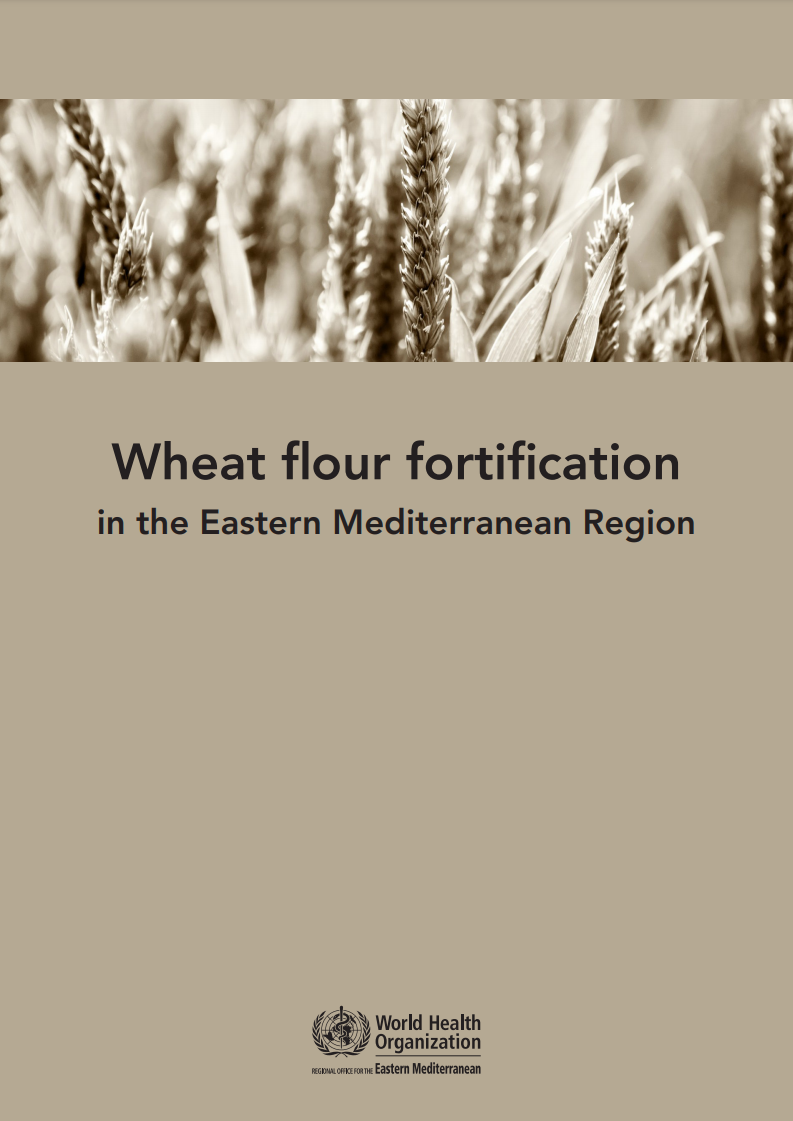
Wheat flour fortification in the Eastern Mediterranean Region
Publication date: 2019
Fortification of industrially-processed wheat flour is a simple, inexpensive and effective strategy for supplying vitamins and minerals to the diets of large segments of the Region’s population. This document summarizes information on the micronutrient deficiencies and the current state of wheat flour fortification in the Region, identifies common challenges and lessons learned from country experiences, outlines the latest guidance on best practices, and makes recommendations to advance appropriate wheat flour fortification in the Region.
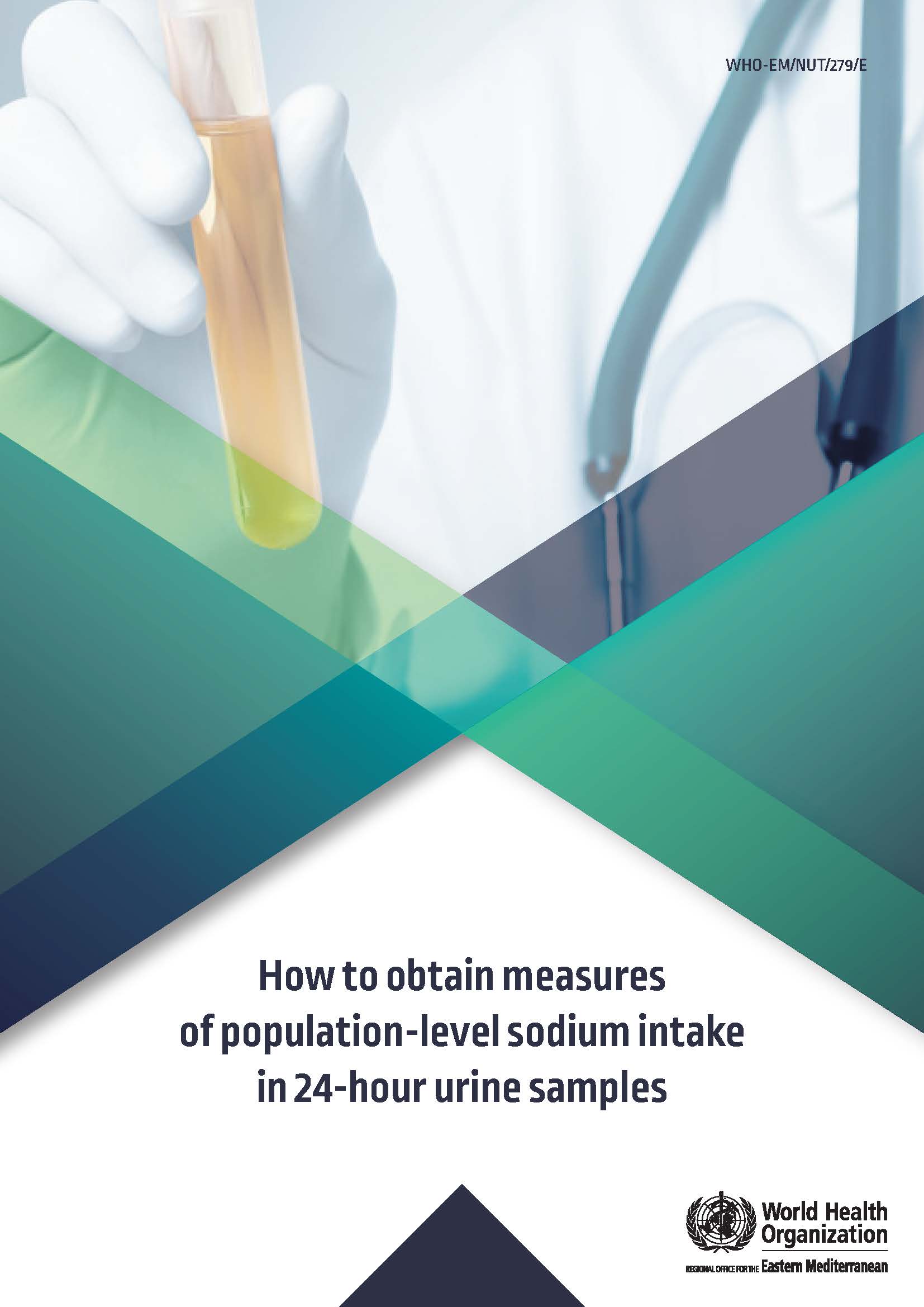
How to obtain measures of population-level sodium intake in 24-hour urine samples
Publication date: 2018
There is compelling evidence of the direct relationship between salt consumption and blood pressure. WHO is coordinating initiatives globally to reduce dietary salt intake at the population level. This document provides an essential salt intake measurement tool for countries in the Eastern Mediterranean Region that want to start, contribute to, and share information on dietary salt reduction initiatives. The protocol is primarily intended for principle investigator(s) of studies of salt/sodium, potassium and iodine intake. Parts of the document are also intended for field staff who are conducting the surveys.

Prevalence and risk factors of iodine deficiency among school children (6–12) years in Kingdom of Bahrain
Publication date: 2014
In many developing countries, children are at high risk of both goiter and iron deficiency anaemia. This study aims to demonstrate the prevalence of goiter, median urinary iodine concentration in school-aged children (6–12 years), and to estimate salt iodine content at the household level in Bahrain. The findings show that goiter prevalence in the studied governorates was low and iodine deficiency disorders are not a public health problem. Median urinary iodine level (247µg/l) was above the threshold level of the recommended level of 100–200µg/l.
Related links
Other WHO guidelines on nutrition
WHO publications repository on nutrition


